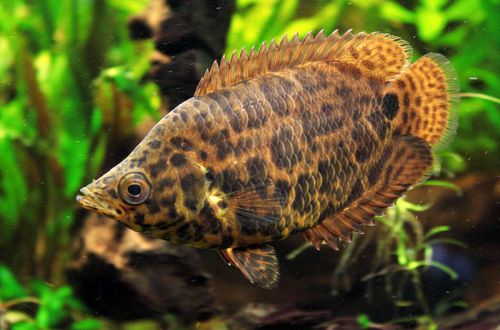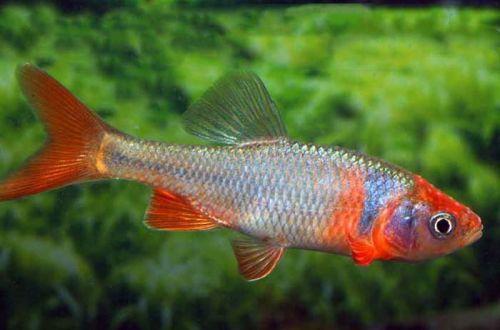
Ctenopoma leopard
The leopard ctenopoma, scientific name Ctenopoma acutirostre, belongs to the Anabantidae family. The spotted predator of African rivers, despite this, is very peaceful towards fish of a similar size. It is nocturnal and prefers to hide in shelters during the day. A hardy and unpretentious species, it is considered a real long-liver among relatives; in favorable conditions, life expectancy is about 15 years.

Contents
Habitat
It originates from the African continent from the vast basin of the Congo River on the territory of the modern states of the Republic of the Congo and the Democratic Republic of the Congo, is found in various biotopes from moving rivers to stagnant reservoirs.
Brief information:
- The volume of the aquarium – from 110 liters.
- Temperature – 24-28°C
- Value pH — 6.0–7.5
- Water hardness – soft to medium hard (5-15 dGH)
- Substrate type – any dark
- Lighting – subdued
- Brackish water – no
- Water movement – any
- The size of the fish is up to 15 cm.
- Food – meat
- Temperament – conditionally peaceful
- Keeping alone, in a pair of male / female or in a group
- Life expectancy – 10-15 years
Description
Adults are able to grow up to 20 cm, however, in aquarium conditions, sizes rarely exceed 15 cm. The color is similar to leopard with numerous dark spots. The color is predominantly brown. The shape resembles a leaf – a pointed head and a high body with a rounded tail and elongated dorsal and anal fins with notches resembling spikes.
Food
Predator, in nature feeds on live fish and large invertebrates. In the home aquarium it is adapted to alternative foods such as frozen shrimp, bloodworms, mussels, shellless snails and earthworms.
Maintenance and care, arrangement of the aquarium
The optimal size of the aquarium for one fish starts from 110 liters. The leopard ctenopoma is nocturnal, so pay special attention to lighting, it should be dim or muffled due to dense floating vegetation. The design uses a dark substrate, branchy driftwood that forms a secure shelter, and African plants such as Anubias and Bolbitis. They look especially impressive attached to pieces of wood.
The presence of a tight cover will allow you to keep a warm, moist layer of air above the surface, which is necessary for the normal breathing of labyrinth fish.
Otherwise, it is a very unpretentious species, perfectly adapts to various conditions in a fairly wide range of pH and dGH values, if they satisfy the allowable values.
Maintenance comes down to regular cleaning of the soil from organic waste and weekly replacement of part of the water (10-15% of the volume) with fresh water in the presence of an effective filtration system.
Behavior and Compatibility
The leopard ctenopoma is tolerant of other species of similar size and even shy, it can be intimidated by overly active tankmates. Such behavior does not betray a predator in it, however, on occasion, it can easily eat a small fish.
Intraspecific relationships are built on the dominance of the alpha male in a particular area, skirmishes are possible in small tanks. Problems can be avoided if the fish grow together and form a hierarchy as they mature.
Breeding / breeding
Successful breeding experiences of this species in the home aquarium are rare. Ctenopoms are critical in choosing a partner, the chances of forming at least one pair become higher if you acquire a group of several fish of the same age.
With the onset of the mating season, the fish perform a kind of mating dance, during which hundreds of eggs are released, which float to the surface and from that moment are left to themselves. Parental instincts are not developed and there is no concern for future offspring, moreover, adult fish can eat their own eggs, therefore, for safety, they are carefully transferred to a separate tank with identical water conditions.
The incubation period lasts about 48 hours, in the next 2 days the fry begin to swim freely in search of food. Feed with a specialized microscopic lump or grown ciliates.
Fish diseases
The main cause of most diseases is unsuitable living conditions and poor-quality food. If the first symptoms are detected, you should check the water parameters and the presence of high concentrations of hazardous substances (ammonia, nitrites, nitrates, etc.), if necessary, bring the indicators back to normal and only then proceed with treatment. Read more about symptoms and treatments in the Aquarium Fish Diseases section.





